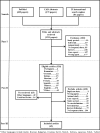A systematic review of the literature on cystic echinococcosis frequency worldwide and its associated clinical manifestations
- PMID: 23546806
- PMCID: PMC3752796
- DOI: 10.4269/ajtmh.12-0692
A systematic review of the literature on cystic echinococcosis frequency worldwide and its associated clinical manifestations
Abstract
A systematic literature review of cystic echinoccocosis (CE) frequency and symptoms was conducted. Studies without denominators, original data, or using one serological test were excluded. Random-effect log-binomial models were run for CE frequency and proportion of reported symptoms where appropriate. A total of 45 and 25 articles on CE frequency and symptoms met all inclusion criteria. Prevalence of CE ranged from 1% to 7% in community-based studies and incidence rates ranged from 0 to 32 cases per 100,000 in hospital-based studies. The CE prevalence was higher in females (Prevalence Proportion Ratio: 1.35 [95% Bayesian Credible Interval: 1.16-1.53]) and increased with age. The most common manifestations of hepatic and pulmonary CE were abdominal pain (57.3% [95% confidence interval [CI]: 37.3-76.1%]) and cough (51.3% [95% CI: 35.7-66.7%]), respectively. The results are limited by the small number of unbiased studies. Nonetheless, the age/gender prevalence differences could be used to inform future models of CE burden.
Figures




References
-
- DerSimonian R, Lard N. Meta-analysis in clinical trials. Control Clin Trials. 1986;7:177–188. - PubMed
-
- De Andrade BB, Carabin H. On the estimation of relative risks via log binomial regression. Revista Brasileira de Biometria. 2011;29:1–15.
-
- Yang YR, Sun T, Li Z, Zhang J, Teng J, Liu X, Liu R, Zhao R, Jones MH, Wang Y, Wen H, Feng X, Zhao Q, Zhao Y, Shi D, Bartholomot B, Vuitton DA, Pleynell D, Giraudoux P, Ito A, Danson MF, Boufana B, Craig PS, Williams GM, McManus DP. Community surveys and risk factor analysis of human alveolar and cystic echinococcosis in Ningxia Hui Autonomous Region, China. Bull World Health Organ. 2006;84:714–721. - PMC - PubMed
-
- Yang YR, Ellis M, Sun T, Li Z, Vuitton DA, Bartholomot B, Giraudoux P, Craig PS, Boufana B, Wang Y, Feng X, Wen H, Ito A, McManus DP. Unique family clustering of human echinococcosis cases in a Chinese family. Am J Trop Med Hyg. 2006;74:487–494. - PubMed
-
- Wang YH, Rogan MT, Vuitton DA, Wen H, Bartholomot B, Macpherson CN, Zou PF, Ding ZX, Zhou HX, Zhang XF, Luo J, Xiong HB, Fu Y, McVie A, Giraudoux P, Yang WG, Craig PS. Cystic echinococcosis in semi-nomadic pastoral communities in north-west China. Trans R Soc Trop Med Hyg. 2001;95:153–158. - PubMed
Publication types
MeSH terms
LinkOut - more resources
Full Text Sources
Other Literature Sources
Miscellaneous

